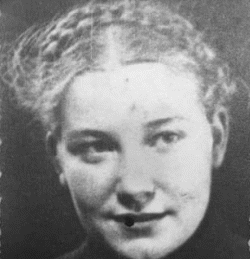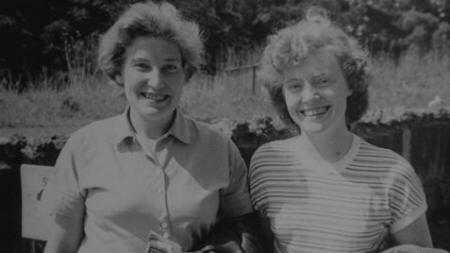

Partner Coral Trimmer
 Pietertje Maria "Riet" Hoogland (September 20, 1920 - August 24, 1970) was the daughter of Wouter Hoogland and Hendrikje Fransen.
She is celebrated with a documentary based on Riet’s war diaries, partly written in a jail in Scheveningen, close to the Dutch coast, where she was locked up with dozens of other members of the Resistance. It was 1941, the war had barely started, and the Nazis were still using trial and error to see how cruel they could be in the countries they had overrun only months before. Riet Hoogland was 21 years old, a normal girl working in a textile factory in Enschede, a country in the north of Holland. She had a well-developed sense of justice, so shortly after the war began she started distributing anti-German pamphlets to her co-workers. In October 1940 she was arrested and sent to prison for a year in early January 1941.
Pietertje Maria "Riet" Hoogland (September 20, 1920 - August 24, 1970) was the daughter of Wouter Hoogland and Hendrikje Fransen.
She is celebrated with a documentary based on Riet’s war diaries, partly written in a jail in Scheveningen, close to the Dutch coast, where she was locked up with dozens of other members of the Resistance. It was 1941, the war had barely started, and the Nazis were still using trial and error to see how cruel they could be in the countries they had overrun only months before. Riet Hoogland was 21 years old, a normal girl working in a textile factory in Enschede, a country in the north of Holland. She had a well-developed sense of justice, so shortly after the war began she started distributing anti-German pamphlets to her co-workers. In October 1940 she was arrested and sent to prison for a year in early January 1941.
This particular prison was already famous at the time. It was called de Oranjehotel (the Hotel Orange) because it housed the crème de la crème of the Dutch Resistance. In a way Riet was a lightweight, small-fry amidst people who had been offering shelter to Jewish families, planned killings of Nazis and set up underground newspapers. But that was a good thing, because this meant the German guards in the prison paid less attention to her than to the others. And this led to a kind of secondary resistance, in goal, with Riet, who had been assigned to scrub the corridors and empty out the lavatories, becoming an intermediary between prisoners.
Because of her people knew what others had said during interrogations and torture, and could warn others on the outside to get out of harm’s way. Because Riet was outside of her cell a lot, she also witnessed some of the worst things the Nazis did to the captives. Once she was sweeping the floor when she saw a group of SS men take turns at whipping a Resistance man until he was one bleeding mass of flesh.

Another time she saw a group of happy hostages, who signed to her that they were being freed to go home. A few hours later, she overheard a guard telling her colleague that the men had been executed nearby.
At the end of 1941, Riet was freed from jail and went back to Enschede. Not long after, the city was bombed. Riet, still only 23, helped out with the aftermath. She dug through the debris with her hands, finding the crushed head of a three-year-old boy and the limbs of other small children, ripped off by the blast and their house falling on top of them. Through all of it, she kept a diary, noting in detail, but often in code, for fear of it being found. Twice she risked her life for it, but it managed to survive the war.
Then hostilities ended. But not for Riet. Because in her diary she had described something that, in the 1940s, was still regarded as a crime. Riet was gay, and strangely enough, that had been less of a problem during the war. Knowing that every day could be your last sharpens the mind, soul and body, and a lot of people had been living dangerously, having relationships and even sex with whomever they wanted. But after the war, everything went back to ‘normal’ and that put Riet back into the category of perverts. Her diary, that she had protected with her life and worked on for years, was refused for publication. And after a few years of trying and failing, Riet decided to get out of stifled, newly prissy Holland.
On 11 January 1953, almost twelve years to the day from her arrival at the Oranjehotel, she boarded a ship and arrived in Auckland. She had no money to speak of and no real education, so for the first year or so she lived in a garage at the back of somebody’s house and washed dishes in one of the local fish restaurants.
One day, a very beautiful and shy-looking girl walked in and Riet was instantly smitten. Coral Trimmer was mightily impressed by the tall Dutch woman, who dared to come up to her and tell her that she was gay and was attracted to her. At the time, New Zealand was as conservative as Holland, and Coral had never met anybody this forthright before.
For a year, the two women travelled the country. Working where they could, pretending to be just friends, but having the time of their lives. Then they settled down in Auckland, where they started a small translating business. Riet, who spoke five languages, took the lead, while Coral supplemented their income by singing and performing in pubs and clubs.
In 1955, television came to New Zealand, and Coral appeared on the very first programme ever broadcasted. She started to dream about a proper career in show business and for that, New Zealanders and Australians at that time believed, you had to be in the centre of the cultural universe: London.
In 1960, she left. Riet stayed behind. It was impossible for her to go back to Europe, the continent of her nightmares, where so much had happened. Coral went anyway and that was the great regret of her life. Because when she came back, ten years later, Riet was dead. She had died of cancer at the age of 49.
The war diaries, together with all her other things, were sent to her nephew, Fred, in Australia, who put the boxes in his attic for forty years. Then they ended up back in Holland, where Riet’s niece Ineke, who had never even heard of her great-aunt, started reading. And couldn’t stop. Now Riet’s book is at the centre of a documentary about her life, and a major exhibition about the Oranjehotel, opened by the Dutch king.
My published books: